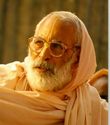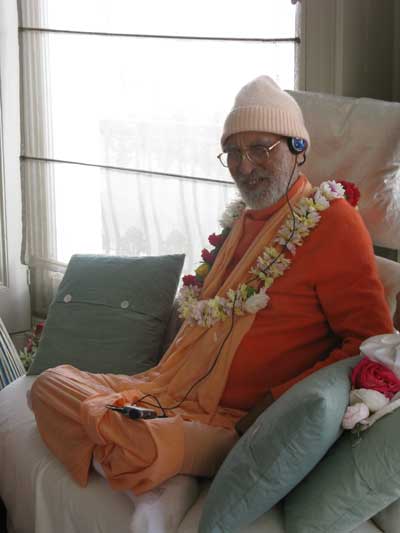

After the Houston Harikatha festival at the end of May, 2009, Srila Narayana Gosvami Maharaja traveled with his party to Brighton, England. There, he spent a few days of rest and writing at the home of Yasodanandana dasa and Ananga-mohini dasi. While in Brighton, he gave one darsan, which was attended by about seventy devotees and guests.
After his short talk, he spoke with the devotees individually, inquiring about their welfare, meeting some for the first time, and replying their sincere questions.
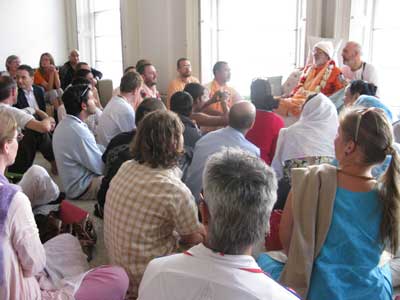
One devotee asked, “In the Bhagavad-gita it says that if one tries to do devotional service and he doesn’t succeed, then in his next birth he may take birth in a Vaisnava family or an aristocratic or wealthy family. I would like to know if a devotee who is trying to practice but isn’t pure when he leaves his body – does he keep taking birth in a Vaisnava family? Or, what happens?”
[Srila Narayana Gosvami Maharaja:] If he has continued practicing bhakti, but has not achieved perfection, he may continue to come in a Vaisnava family. It depends on his eagerness in bhajana. If his bhajana is high-class, then he will reach perfection very soon; otherwise it could take thousands of births, but it will continue life after life.
Have the Gangamatas gone to Italy yet? I am very happy with them, for their preaching and book distribution. I am very, very happy.
After his short visit to Brighton, Srila Maharaja journeyed with his party to his 2009 European Bhakti Festival in Italy, which began on June 6th. The festival was held in a holiday resort on the ocean, just outside of Venice, Italy. It was largely organized by Lila-purusottama dasa, his wife Krsna-devi dasi, and their three children, who had begun preparing for it in the beginning of January. It was the largest attended festival outside of India, with over one thousand devotees and guests present.
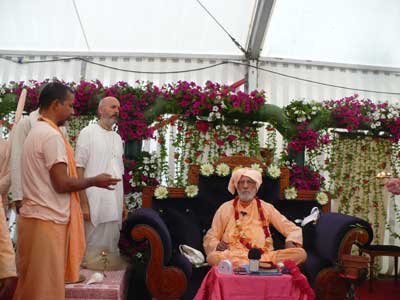
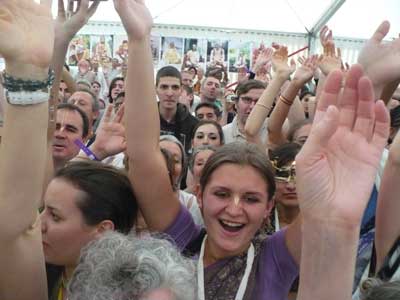
Srila Maharaja spoke for six nights on the pastimes of Sri Caitanya Mahaprabhu and the reasons for His descent. Before he began speaking about Sri Caitanya Mahaprabhu, he said, “Now we will begin Sri Caitanya-caritamrta. Why did Krsna come in the form of Sacinandana Gaurahari (Mahaprabhu)? There are so many reasons which we will describe, but before that, I want to say that without the mercy of Sri Guru, we cannot be successful in understanding or following Sri Caitanya Mahaprabhu. First, the mercy of guru is needed, and that is why the author of Sri Caitanya-caritamrta, Srila Krsnadasa Kaviraja Gosvami, first offered obeisances to his siksa-gurus (many instructing spiritual masters), diksa-guru (initiating spiritual master), patha-pradarasaka guru (the guru who first shows the path), and caitya-guru (Sri Krsna, in the form of the Supersoul, who is present in the heart of all).
“Inwardly and outwardly, guru gives knowledge. First, Krsna Himself told Uddhava-samvad, which is the gist of the entire Srimad-Bhagavatam; and He directly spoke the Bhagavad-gita. So, He is the original guru:
“krsna hoite catur-mukha, hoya krsna-sevonmukha,“The first guru is Krsna, and after that Brahma, then Narada, Sanaka and Sanat-kumar (of the Four Kumaras), and so on. There are four sampradayas, or lines of authorized disciplic succession: Sri, or Laksmi; Brahma; Rudra; and the Four Kumaras, namely Sanaka, Sanatana, Sananda, and Sanat-kumara. In the siksa-parampara of these four transcendental personalities, as the parampara acaryas, are Madhvacarya, Ramanuja, Visnu-svami, and Nimbaditya.*[See endnote 1] There are hardly any followers of Nimdaditya nowadays. His following is almost extinct, whereas there are so many followers from the other three sampradayas.
brahma hoite naradera mati
narada hoite vyasa, madhva kohe vyasa-dasa,
purnaprajna padmanabha-gati (1)[“In the beginning of creation Sri Krsna spoke the science of devotional service to four-faced Lord Brahma, who in turn passed these teachings on to Narada Muni, who accepted Krsna Dvaipayana Vyasadeva as his disciple. Vyasa transmitted this knowledge to Madhvacarya, who is also known as Purnaprajna Tirtha and who was the sole refuge for his disciple Padmanabha Tirtha.”]
”Srila Madhavendra Puri appeared in the Brahma-Madhva-sampradaya. He is said to be the first sprout of madhurya-prema in that sampradaya (disciplic line). From him came Srila Isvara Puri, and then Sri Caitanya Mahaprabhu Himself. With Him came Sri Svarupa Damodara, Sri Raya Ramananda, Srila Rupa Gosvami, Srila Sanatana Gosvami and the other Gosvamis. Then came Srila Narottama dasa Gosvami, and then Srila Visvanatha Cakravarti Thakura and then Srila Baladeva Vidyabhusana prabhu. Then came Jagannatha dasa Babaji Maharaja, Srila Bhaktivinoda Thakura, and Srila Bhaktisiddhanta Sarasvati Thakura, and from him came our Gurudeva Srila Bhakti Prajnana Kesava Gosvami Maharaja and Srila Bhaktivedanta Swami Maharaja and many other disciples, and now we are coming in his line.
“We are so fortunate that we are in Sri Caitanya Mahaprabhu’s line. In this line, the speciality is unnata-ujjvala-rasa, parakiya-bhava*[See endnote 2], which is not given in any other sampradaya.”
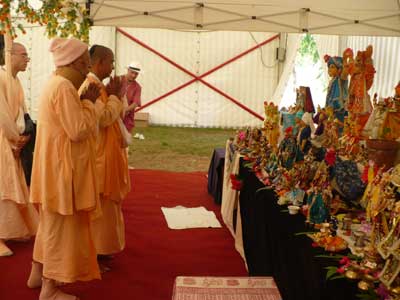

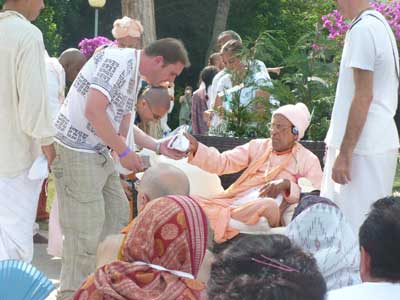
There were two initiation ceremonies, at which time over one-hundred-twenty aspiring devotees received harinama and/or diksa-initiation.
On June 8th, about seven-hundred devotees went on a grand harinama sankirtana. Buses shuttled them to the ferry that took them across the water to Venice. The kirtana began from the moment they boarded on the buses, and did not end until they returned to the festival-site hours later.
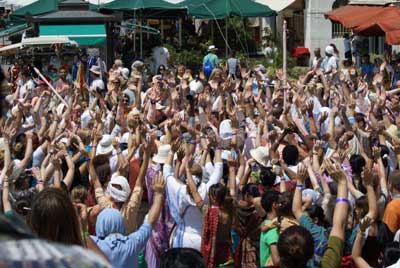

The organizers of Srila Maharaja’s festival arranged to rent an entire ferry for the devotees, and devotees were chanting and dancing on the boat on the way to Venice.
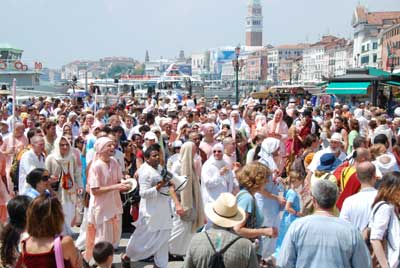
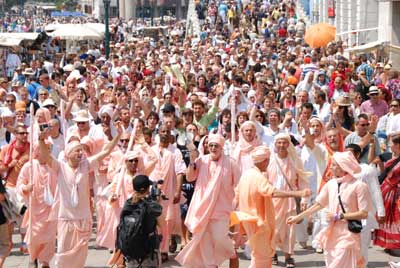
On June 12th, the last day of the festival, Srila Maharaja came to the pandal at about 10:30 am. Various devotees gave “thank you” speeches to the organizers and others who helped, and then Srila Maharaja spoke the following:
“I think that this festival has been an all-around success. There was good prasadam, good management, and very high-class hari-katha.
“I want that all my disciples, those I have given harinama and diksa, should be strong in chanting as much as they can. They should chant no less than sixteen rounds daily. Also, they must daily chant their diksa-mantras three times, without fail: one in the morning, one at noontime, and one in the evening. If you can’t chant your diksa mantras in midday, then you can chant them two times in the morning: one time for the morning and one for noon. Don’t fail to do this.
“I have heard from so many sources that the devotees are very inspired while at the harikatha festivals, but after I depart they become very weak. Sometimes they chant, or they hang their japa-mala in a high place and don’t chant at all, and they don’t meditate on their diksa-mantras. This is all due to a lack of sadhu-sanga.
“sadhu-sanga’, ‘sadhu-sanga’—sarva-sastre kaya“If you have no money problems, you can come to Vrndavana for Vraja Mandala parikrama. I am inviting you all. If you can come to Navadvipa-dhama parikrama in February / March, then please come there as well.
lava-matra sadhu-sange sarva-siddhi haya[“The verdict of all revealed scriptures is that by even a moment’s association with a pure devotee, one can attain all success.”
(Caitanya-caritamrta, Madhya-lila, 22.54)]
“Take in your heart whatever we have discussed in class this week, and read our books. And especially, as Srila Bhaktivedanta Swami Maharaja inspired all of his disciples, ladies and men, to distribute his books in the midst of oceans, tops of hills, schools, colleges, universities, and everywhere else, similarly, I request all my disciples to also distribute my books, door to door. *[See endnote 3]
“Ninety percent of my books have gone from the book table here, but why are 10% still remaining? I think you should take them and distribute them here and there. I want my book table to be empty.
“Finally, what I have told before, again I am telling: Keep this harikatha in your heart and be happy forever.”
Gaura-premanande, hari hari bol.
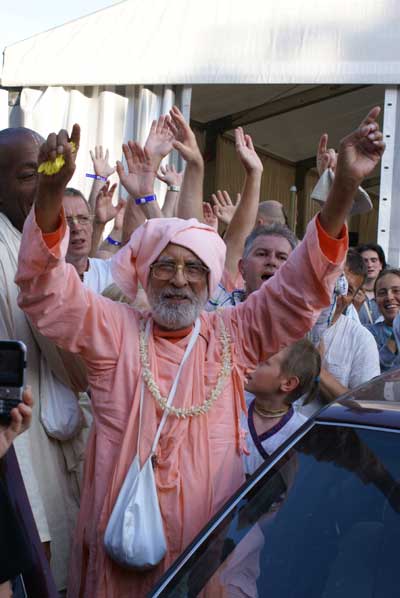
Before getting into his car to return to his quarters, the devotees, as it usually happens in all his festivals, sang, “Govinda Damodara Madhaveti.” Then Srila Maharaja called out, “Jaya Jaya Sri…” and the devotees replied “Radhe!” – three times.
[*Endnote 1: “There are four sects of worshipful devotees of the Lord, and the chief amongst them are the Brahma-sampradaya, Rudra-sampradaya and Sri-sampradaya, descending directly from Lord Brahma, Lord Siva, and the goddess of fortune, Laksmi, respectively. Besides the above-mentioned three sampradayas, there is the Kumara-sampradaya, descending from Sanat-kumara.” (Srimad-Bhagavatam, Purport, 1.18.21)]
[*Endnote 2: “Because Sri Caitanya Mahaprabhu is Krsna, He can distribute vraja-prema, and especially parakiya-bhava (love between a paramour and the beloved), which is called unnatojjvala-rasa. Unnata means 'highest', and ujjvala means 'brilliantly shining.' And the word rasa refers to the mellow of a specific relationship with Krsna. The brilliance of unnatojjvala-rasa is unparalleled, and all of our acaryas in the Gaudiya sampradaya have come to this world to teach this. They did not come to taste what Sri Caitanya Mahaprabhu came to taste, but to distribute this same rasa which He came to distribute.” (Pinnacle of Devotion, by Srila Bhaktivedanta Narayana Gosvami Maharaja)]
[*Endnote 3: Morning Walk in Houston, May 28, 2009:
Ramacandra dasa (Badger): Srila Gurudeva, can you speak a little bit on the importance of book distribution?
Srila Narayana Gosvami Maharaja: By distributing books, Srila Bhaktivedanta Svami Maharaja preached all over the world. His books went from house to house, to the forests and mountains, to all cities, hotels, and bookstores. I want my disciples to distribute the books in the same way. They should reach every house, all over the world. I want to thank you for distributing so many books.]
![[BVML Home Page]](../../grfx/bml_logo.gif)
